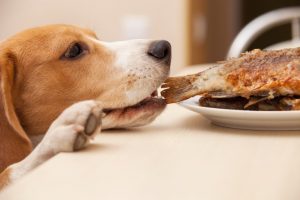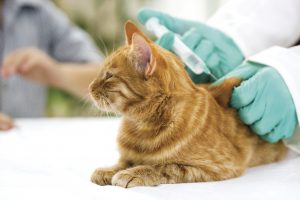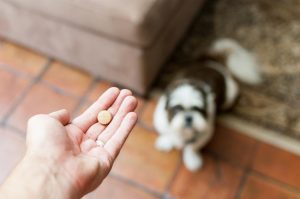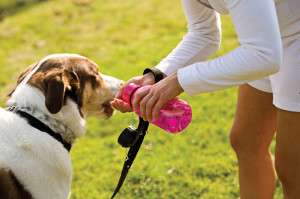Posts Tagged ‘vet in Glen Carbon’
Holiday Pet Toys For 2017
 With the holidays rapidly approaching, pet owners usually ask for gift ideas for their four-legged companions. As with every other Santa’s list from our children, electronics and technology play an important part in holiday pet toys. So without further adieu, I will introduce some ideas that might be appealing to the pet owner with the pet in mind.
With the holidays rapidly approaching, pet owners usually ask for gift ideas for their four-legged companions. As with every other Santa’s list from our children, electronics and technology play an important part in holiday pet toys. So without further adieu, I will introduce some ideas that might be appealing to the pet owner with the pet in mind.
- Bascolor Electric Rotating Butterfly– This gift from Amazon is for the cat owners who want to keep their kitten active. It is described as a butterfly that flashes in the dark that will fulfill your kitty’s hunting urges.
- Cat Scratcher Lounge– This cardboard lounge is infused with catnip that your cat is going to be addicted to in record time. It also can be used as a scratch board. Available from Amazon for about $20.
- K&H Crinkle Sack Cat Bed– This cat bed makes the noise of a paper bag that your cat will love. Inside, it is covered with a plush lamb wool that is easy to wash and take care of. The overstuffed bolster keeps the sack open for easy access for your kitten. It is also available on Amazon.
- Nerf Tennis Ball Blaster– This toy will launch tennis balls 50 feet in the air and is easy to operate. It works with standard tennis balls but if you get the lighter replacement balls they will go farther. No need to touch the slimy ball because it is easy to reload.
- Pet Acoustics Pet Tunes Calming Music Dog Speaker– A bluetooth speaker that is preloaded with 90 minutes of music developed by a sound animal behaviorist to reduce stress and calm nervous canines. It alleviates stress and related behaviors such as excessive barking and pacing which can happen when your pet is home alone during thunderstorms, traveling or when it is adapting to new environments. It comes complete with a rechargeable battery.
- GPS tracking systems– There are many available for the high tech owner that can have a GPS and activity monitor which set up virtual fences to indicate safe zones and give notifications where your pet has traveled too far. They range in price starting at $39.
- Furbo Dog Camera– For the really techie person that wants to see, talk and toss treats to your dog even when you are not at home. It gives smart dog alerts and the camera gives peace-of-mind to the dog’s parents. The camera lets you see, talk and toss treats from anywhere and sends alerts when your dog barks. The two-way camera allows you to hear and speak to your dog and works with Amazon Alexa.
- Pet DNA testing– By discovering your pet’s ancestry, pet owners and veterinarians can work together to tailor wellness plans that fit the unique one-of -a-kind needs of the dog. It helps owners discover typical ailments that certain dogs can have over one another and provide insight to personality traits of the breeds in your dog’s genetic make up. It is also available for cats. Price ranges from $70 to $180.
This is not an all-inclusive list, but it may give pet owners ideas when shopping for our four-legged friends. At this time, I would like to thank each and all of my clients for their loyalty and business that have come my way. May each and everyone have a happy and safe holiday season and a prosperous 2018. Don’t forget to contact us at any time, even during holiday emergencies, if you have any questions.
The Trouble With Table Scraps
 If the holidays are at your place like it is at our place, it is family, food and football—not necessarily in any order. Unfortunately many pet owners think that holiday time means giving their pets a taste of the tender morsels that they partake in. Before you give table scraps – STOP and think a minute. These high-fat type of foods or foods that your pet is not accustom to can lead to disaster if given to our pets. Just a small amount can lead to pancreatitis in our pets, which can lead to terrible consequences.
If the holidays are at your place like it is at our place, it is family, food and football—not necessarily in any order. Unfortunately many pet owners think that holiday time means giving their pets a taste of the tender morsels that they partake in. Before you give table scraps – STOP and think a minute. These high-fat type of foods or foods that your pet is not accustom to can lead to disaster if given to our pets. Just a small amount can lead to pancreatitis in our pets, which can lead to terrible consequences.
If your pet develops pancreatitis, the treatment focuses on supportive care, such as controlling nausea and vomiting, preventing further dehydration or imbalances in the blood and feeding a low-fat nutritious diet. Serious cases may mean hospitalizing your pet for a few days or longer. Unfortunately, many other diseases have these clinical signs and it makes it a challenge determining if your pet has pancreatitis.
Early diagnosis and treatment is the key to preventing other complications such as dehydration and other systemic diseases.
As your pet ages, he can develop intolerances to certain foods so it may be best to just feed high quality pet foods with little variance and only allow healthy pet treats in moderation.
Most owners know that a only a good quality diet is necessary for their pet, however sometimes good intention visiting guests can complicate things by letting them finish their plate or giving them all of the trimmings off the turkey because they couldn’t resist.
This kind gesture could lead to the previous mentioned consequences.
To avoid pancreatitis a pet owner may take precautions to prevent it. This may include:
- Ask guests to not feed your pet table scraps
- Have healthy treats present if your guests can’t resist
- Keep pets out of the garbage
- Place your pet in a quiet room during mealtime or feed it prior to you and your guests eating
Holidays are all about celebrating and pets are a big part of our family. Kind gestures like feeding table scraps can put a damper on the celebrating if it involves an emergency trip to your veterinarian. So if you set ground rules and make your guests aware of the restrictions for your pets, we can have a safe and happy holiday season.
Olsen Veterinary Clinic is committed to the health and happiness of your pet. For questions, or to schedule an appointment, contact us here.
Dr. Olsen’s Breed Spotlight: The Savannah Cat
 Every once in a while I will spotlight a breed in my newsletters. I have done a couple of dog breeds, but this month I have decided to write one for our furry, feline friends. The breed is called the Savannah Cat. It is a cross between the wild African Serval Cat and a domestic breed—most commonly the Bengals, Egyptian Maus and Oriental Shorthairs. The actual first Savannah was born on April 7, 1986 from parents that were the Serval cat and a Siamese. The kitten’s name was ironically named Savannah. After several years of breeding and creating the new breed standard, the new breed was recognized in 2012 by the International Cat Association.
Every once in a while I will spotlight a breed in my newsletters. I have done a couple of dog breeds, but this month I have decided to write one for our furry, feline friends. The breed is called the Savannah Cat. It is a cross between the wild African Serval Cat and a domestic breed—most commonly the Bengals, Egyptian Maus and Oriental Shorthairs. The actual first Savannah was born on April 7, 1986 from parents that were the Serval cat and a Siamese. The kitten’s name was ironically named Savannah. After several years of breeding and creating the new breed standard, the new breed was recognized in 2012 by the International Cat Association.
Most Savannahs have a tall, lean build that gives them the appearance of greater size than their actual weight. This trait has given them the title as being the world’s tallest domestic cat breed in the Guinness Book of World Records since 2006. They are long legged, and if they were athletes, they would be heavily recruited by basketball teams! The Savannah’s can weigh between 8 to 20 pounds and come in many different colors and patterns, such as black, brown, or black spotted tabby; black silver spotted tabby; or black smoke. Most have solid black or dark brown spots on golden, cream, sandy or white backgrounds. They stand out for their bold, solid markings, which can be round, oval, or elongated. Other colors and patterns do exist and can be registered into the breed register but cannot be shown. Savannahs have a triangular head that is supported with a long neck and topped by large, wide ears. They have medium sized eyes that can be any color but are usually blue at birth. This breed takes about 3 years to reach maturity and their back legs are usually a little longer than their front.
The Savannahs are NOT a sweet, quiet lap cat. However they are very active, confident and enjoy reacting with people and other cats. They are intelligent and curious and always looking for something interesting to do—the more adventurous the better. They have a knack for being quite mischievous and are not a good fit for owners that are away a lot or not active. So it may be best to have a companion for them.
This breed is not cheap to own, due to the confirmation of the breed standard, their temperament, demand and scarcity. The F1 Savannah cats which are 50% – 82% or higher wild blood can sell for up to $22,000 because mating is very difficult. They have very small litters and very low fertility. The F1 offspring do not like to be held, but like to be petted, scratched and be in contact with humans. They tend to gravitate to one person and get along with other pets just fine. F1’s are also the largest of the breed, where they can weigh up to 30 pounds. As more domestic blood introduced, the Savannahs will be smaller, but can be more enjoyable members of the family as far as personality goes.
So if you have a Savannah or even a domestic “four legged” furry feline friend, Olsen Veterinary would be happy to make sure that they remain healthy. Please call the office at 618-656-5868 if you have any concerns or would like to schedule an appointment. You can also go to our website and request an appointment. Our team would then be able to set that up.
Everything You Ever Wanted To Know About Pet Vaccines
 Pet vaccines are important, and they have a long history. Probably the most important technological gains were discovered in the 1790’s by Dr. Edward Jenner. He discovered the first vaccination by giving people a preparation of material from cowpox, which was a common animal disease in cattle. The people that were injected with or “vaccinated” with the material did not get sick and remained healthy when they were exposed to the deadly smallpox virus. Over 100 years later, a French scientist by the name of Louis Pastuer, found that they could protect people and animals from disease by injecting altered forms of microorganisms.
Pet vaccines are important, and they have a long history. Probably the most important technological gains were discovered in the 1790’s by Dr. Edward Jenner. He discovered the first vaccination by giving people a preparation of material from cowpox, which was a common animal disease in cattle. The people that were injected with or “vaccinated” with the material did not get sick and remained healthy when they were exposed to the deadly smallpox virus. Over 100 years later, a French scientist by the name of Louis Pastuer, found that they could protect people and animals from disease by injecting altered forms of microorganisms.
The process of how a vaccine works is a complex reaction that involves many chemical and cellular reactions within and between the immune system cells of the body. Basically the role of the vaccine is to expose the immune system of the pet to viral and bacterial antigens that are contained in the vaccine. In the future, when the pet is exposed to that related organism, the body will recognize it and then activate the immune system to prevent the disease from producing or reducing the signs of clinical disease.
Vaccines can be administered by subcutaneous or intramuscular injections, intranasal or orally. The vaccines that are injected or given orally tend to produce a more systemic or whole body response, whereas the intranasal provides a more local response. Intranasal vaccines can be advantageous to provide a quicker response and prevent or kill the new virus before it can get any further in the body. Local nasal vaccines would not be helpful for a virus that has been ingested and causes intestinal disease such as parvovirus in dogs. For that we would want a vaccine that would produce a more systemic response.
The vaccines that we use in veterinary medicine are most generally either a killed or a modified live (attenuated) vaccine. There are multiple indications for both, but generally speaking the killed vaccines are safer and unlikely to cause disease in the immunocompromised pet. Whereas, the live vaccines provide a more amplified response that leads to a better, longer lasting immune protection. Several of the vaccines that we use have many different viruses in one injection. This allows to vaccinate for several of the organisms in one injection.
To confuse you even more, pets get some protection through the placenta when the puppies and kittens are in the mother’s uterus and when they get colostrum which is the first milk that they drink. This protection will decrease over time and usually will be low enough by 12 weeks of age where vaccinations will start reacting. There is no way to measure quick, easy and inexpensive way to measure the immunity gained here, so we generally recommend starting vaccines at 6 to 8 weeks of age and then booster them every 2 to 4 weeks until they are 16 weeks of age. Generally, it is not the number of vaccinations that they get, but when they get them at their chronological age.
A vaccine helps prime an animal against a specific disease. It does this by stimulating the immune system with a nonpathogenic virus or bacteria. If the animal responds adequately, it will develop cells that will help it to quickly and efficiently fight off the pathogenic form of the agent if it is encountered later. Here at Olsen Veterinary Clinic, we have tailored our vaccination programs to meet the needs of your pet. If you have any questions please feel free to contact us here, or call our office at 618-656-5868.
Human Medications and Pet Medications Are NOT Created Equal
 In today’s society, almost everyone has some medications – whether over-the-counter or prescription sitting around at home. The important thing to remember, however, is that human medications and pet medications are NOT created equal. While some human medications are safe, some can be very toxic to pets if they happen to ingest them. As a matter of fact, the Pet Poison Hotline reports that nearly 50% of the calls involve human medications. These issues can arise if your pet accidentally chewed into the pill bottle or a well-intentioned pet owner gave their pet a human medication. Pet poisonings are common, can be very serious, and spell disaster for a beloved pet.
In today’s society, almost everyone has some medications – whether over-the-counter or prescription sitting around at home. The important thing to remember, however, is that human medications and pet medications are NOT created equal. While some human medications are safe, some can be very toxic to pets if they happen to ingest them. As a matter of fact, the Pet Poison Hotline reports that nearly 50% of the calls involve human medications. These issues can arise if your pet accidentally chewed into the pill bottle or a well-intentioned pet owner gave their pet a human medication. Pet poisonings are common, can be very serious, and spell disaster for a beloved pet.
With that in mind, listed below are 10 medications that can cause toxicity to your pet and therefore should be kept away from them.
NSAIDS – Non-Steroidal Anti-Inflammatory Drugs are common, everyday drugs that are found in most households. This classification includes popular drugs like Aleve, Advil and Motrin. The side effects can be some of the most dangerous drugs for pets to ingest. In fact just 1 or 2 pills can cause pets to suffer serious stomach and intestinal ulcers and in some cases cause kidney failure.
Acetaminophin – For that occasional headache or fever, almost everyone has some Tylenol sitting around their home. As safe as it is for children the opposite is true for pets. Just a small dose of acetaminophin can cause damage to your pet’s red blood cells, reducing its ability to carry oxygen through the body. The drug can also cause liver damage in your pet.
Birth Control Pills – Dogs usually mistaken the birth control containers for toys, but if they swallow a large number, they can get ill. Estrogen and Estradiol have shown to cause bone marrow suppression in pets. Surprisingly, female pets have an increased risk of suffering from the most serious side effects.
Antidepressants – Veterinarians have at times prescribed medications meant for humans to pets like Prozac. When used as your veterinarian has prescribed, they are safe. But accidental or overdose can be toxic to your pet. These clinical signs can include serious neurological problems that include sedation, loss of coordination, tremors and even seizures.
ADHD/ADD Medications – Prescription medications for this human condition are very strong stimulants like amphetamines and are very dangerous for pets. Ingestion of small amounts can cause life-threatening tremors, seizures, elevated body temperature and heart problems. Drugs in this category include Adderall, Ritalin and Concerta.
Benzodiazepines and Sleep Aids – Drugs like Xanax and Ambien are given to humans to reduce anxiety and help sleep better. However in pets, it can cause the opposite. It has been shown that small doses can cause pets to be agitated, along with severe lethargy, incoordination, and a slowed breathing rate. In cats, it has been known to cause liver failure.
Beta-blockers – Beta-blockers are commonly prescribed drugs for humans suffering from blood pressure problems. But all it takes is a small amount for pets to ingest to make it life-threatening to them. These drugs can cause severe drops in blood pressure and a very slow heart rate.
Ace-Inhibitors – Like in humans, these drugs are often used in veterinary medicine to treat pets suffering from high blood pressure. Though typically safe, overdoses can cause low blood pressure, dizziness, and weakness. If pets have ingested just a small amount of this medication, they can be monitored at home unless they have kidney failure or heart disease.
Cholesterol-Lowering Drugs – Drugs like Lipitor are advertised on the TV and are now found in many households in America. While these drugs are considered statins, long term use can potentially leads to problems. In most cases, one may see some mild form of intestinal upset which would include vomiting or diarrhea.
Thyroid Hormones – These medications are routinely prescribed for pets that have underactive thyroids. Surprisingly the thyroid hormone needed to treat dogs is much higher than a persons dose. So, if dogs accidentally get into thyroid hormones, it rarely results in problems. In cats it can be a different story. Large overdoses in cats can cause muscle tremors, nervousness, panting, a rapid heart rate and aggression.
Most pets are naturally curious creatures so it is important to keep them out of reach from your pets. Here are some tips to help ensure that they never ingest your medicine.
- Never leave loose pills in a plastic sandwich bag-the bags are too easy to chew into. Make sure the rest of the family does the same, keeping their medications out of reach.
- If your medication is in a pill box or weekly pill container, make sure that it is safely stored in a cabinet. Too many pets may think that it is a plastic toy.
- Never store your pets medication near your medications. Pet poisonous hotlines received several calls every year from concerned owners who have inadventantly given their own medication to their pet.
- Hang up your purse or backpack. Curious pets will explore the contents of your bag and simply placing it out of reach solves the problem.
A lot of pet poisonings stem from pets ingesting human drugs and pets metabolize the drugs differently than humans do. So because of this, even safe over-the-counter medications may cause serious poisonings in pets.
If your pet has ingested a human over-the-counter or prescription or medication, please call your veterinarian, your local emergency animal hospital or the Pet Poison Hot Line’s 24 hour animal control center at 800-213-6680 immediately. Of course, if our office can be of any assistance, do not hesitate to call or contact us here.
How To Prevent Heatstroke With Your Pet
 With the dog days of summer upon us, we as pet owners need to be aware of heatstroke with your pet. This can be a life-threatening condition that occurs because your pet cannot lower its body temperature efficiently, so its body temperature increases to dangerous levels.
With the dog days of summer upon us, we as pet owners need to be aware of heatstroke with your pet. This can be a life-threatening condition that occurs because your pet cannot lower its body temperature efficiently, so its body temperature increases to dangerous levels.
There are many common situations that can set the stage for heatstroke. These include: strenuous exercise in hot, humid weather, being a brachycephalic (short-nosed) breed, suffering from heart or lung disease that interferes with efficient breathing, being confined without shade or shelter and fresh water in hot weather, being confined on concrete or asphalt and the most logical-left in a closed up car in the warm weather.
Heatstroke begins with heavy panting and difficulty breathing. The tongue and mucous membranes appear bright red. The saliva is thick and tenacious and the dog usually vomits. The rectal temperature rises to 104 to 110 degrees Fahrenheit. The dog becomes progressively unsteady and passes bloody diarrhea. As shock sits in, the lips and mucous membranes turn gray. Collapse, seizures, coma and death rapidly ensue.
It is important to take emergency measures to begin cooling your pet immediately. One suggestion would be to move it to an air-conditioned building and begin cooling your pet with spraying your pet with a garden hose or immersing it in cool water for up to two minutes. Also if possible, it is helpful to place the wet pet in front of an electric fan. Ice packs work well when applied to the groin and armpit areas because this is the area where the blood is the closest to the surface in the body. Monitor the rectal temperature and continue the cooling process until it falls to 103 degrees. Seeking veterinary assistance is of utmost importance since this is an emergency. Your veterinarian will take steps to reverse the effects of heat, dehydration, and low blood pressure. An IV catheter will be placed and fluids will be given to help get blood flowing to major organs again.
Treatment is aimed to supporting these organs in the hope that the damage that they have sustained isn’t permanent. Unfortunately, it will often take days to know which organs have been affected. Specific treatments may include antibiotics, blood pressure medications and blood transfusions.
Because heatstroke can be so deadly and strike rapidly, it is best to take steps to prevent it. In hot weather, it is best to exercise your pet during the coolest part of the day (early morning and late evening) and always provide plenty of fresh, cool water and rest. A person can also help their pet by cooling them by allowing them to swim or spray them off with a hose after exercising.
Never leave a pet in a car during warm weather-not even for a few minutes with the windows cracked. Brachycephalic dog owners should be extra vigilant, keeping their dogs inside in air-conditioning on hot days. All geriatric, obese, and respiratory compromised pets should be exercised with caution in hot weather.
So remember if your pet is acting distressed, start cooling it down and seek assistance from your veterinarian immediately.
Summer Dangers For Pets
 Oh the dog days of summer. What’s not to like about summer? Vacations, cookouts, swimming—can it get any better than that? Wait a dog gone minute though. These fun times can be hazardous to your pets, so care must be taken to make sure that they don’t succumb to the dangers that can be lurking. Accidents can happen almost anytime and anyplace so it is important to be aware of how to prevent them from happening. These can include but not be limited to heat stroke, swimming pools, venomous pests, campouts, bbq and other foods just to name a few. So let’s cover a few dangers to avoid and try to prevent.
Oh the dog days of summer. What’s not to like about summer? Vacations, cookouts, swimming—can it get any better than that? Wait a dog gone minute though. These fun times can be hazardous to your pets, so care must be taken to make sure that they don’t succumb to the dangers that can be lurking. Accidents can happen almost anytime and anyplace so it is important to be aware of how to prevent them from happening. These can include but not be limited to heat stroke, swimming pools, venomous pests, campouts, bbq and other foods just to name a few. So let’s cover a few dangers to avoid and try to prevent.
Summer Heat
The summer heat can be dangerous to our pets. Dogs are covered with hair, have very few sweat glands, and some breeds have shortened noses that make it tough to keep cool in the summer. So the easiest way to beat the heat is to adjust your walking schedule to the morning hours when it is cooler out. Some dogs may do well with having their haircoat shaved, however breeds like the Husky have a haircoat that also helps keep them cool in the summer.
The heat will also warm up the inside of your car, so if it is above 65 degrees either leave your pet at home or take it inside with you when you leave the vehicle.
Sunburn can also cause some problems, so it may be important to put sunscreen on the pets ears and bare skin to prevent this.
Swimming Pools
What is a better way to beat the heat than swim in a swimming pool? It is great and it also is a good way for your dog to get exercise. Floatation devices are available to assist the pets that are not strong swimmers. But, do not leave them unsupervised. It is important that they be taught how to exit the pool safely before they tire. Also having fresh water for them to cool off with and to remove the chlorine, salt and bacteria that can be harmful to them is beneficial. So keep a bowl handy by the pool.
Fireworks
Almost everyone celebrates the Fourth of July with fireworks. Dogs tend to not like loud noises and can be scared easily. The best advice would be to leave your pets at home inside and away from the flash of the fireworks.
BBQs
Some summer evenings are spent socializing with friends and barbecuing. We all like them, and even our pets are hoping for a few table scraps. A little of this and a little of that can be bad for pets—and not just their waistlines. Some surprising foods like grapes, onions, garlic and raisins, can be toxic to dogs if consumed in large quantities and should stay off their menu. Other barbecue staples like corn on the cob, bones, fruit with pits, skewers or ice cream can be dangerous to our four-legged family members. It may be helpful to talk to guests and children before summer parties and politely remind them that table food could be detrimental to the health of your pet.
Fleas & Ticks
While our the heat puts a strain on our pets, fleas and ticks thrive during this time. They can cause disease and carry other parasites that are detrimental to the health of our pets. Just like humans, pets can have allergic reactions to insect and spider bites. By grooming your pet frequently, you can check for the presence of the pests, hot spots, and other skin problems that can be caused by these pests. There are some very good flea and tick medications out there to prevent the problems before they start, so talk with your veterinarian to see what they would suggest. You can also order directly from our store.
Heartworms
Heartworms are carried by mosquitos, and the summer months are when mosquitos thrive and pose the greatest threat to your pet. The heartworms can be very dangerous to the health of your pet. It is best to have your pet on a medication to prevent your pet from contracting the painful disease. So ask your veterinarian for their recommendations.
These dangers may sound scary, but a little preparation and watchful eye is all you need to take the heat off your summer. If you have any questions, please don’t hesitate to call the Olsen Veterinary Clinic at 618-656-5868, or contact us here.
Parasite Prevention And Your Pet
 Parasite prevention and your pet is something very important. With summer fast approaching, pet owners are more active with their pets outside. That is where you will find parasites that can infest your pets, several of which can infect people as well. So because of this, parasite prevention is not only important for the health of your pet but also for the health of your family.
Parasite prevention and your pet is something very important. With summer fast approaching, pet owners are more active with their pets outside. That is where you will find parasites that can infest your pets, several of which can infect people as well. So because of this, parasite prevention is not only important for the health of your pet but also for the health of your family.
As a veterinarian, we generally talk about controlling and preventing four major parasite groups—Fleas and Ticks, Intestinal Parasites, and Heartworms.
Fleas and Ticks
Fleas and ticks are troublesome parasites of the skin. Not only are they troublesome because they cause problems with the skin, they also transmit several diseases to your pet. There are many effective products out there that can be purchased from your veterinarian to control and prevent flea and tick infestations. Regular use of these products can prevent fleas and ticks from becoming a problem to your pet. As tempting as it might be to purchase an over the counter product from your pet store or big box store, I would caution you as a pet owner to be very careful. Many of these products can have serious side effects if used improperly and may have limited effectiveness.
Intestinal Parasites
Intestinal parasites can cause pets to vomit, have diarrhea, lose weight, and lead to a poor overall condition of your pet. The most common intestinal parasites in cats and dogs are roundworms, hookworms, whipworms, tapeworms and coccidia. All of these parasites can have the ability to affect your pet. Additionally, some roundworms, hookworms, and some tapeworms can also affect humans. Because of this, pet owners should contact their veterinarian to check on a routine testing schedule and monthly preventatives.
Most parasites cannot be seen with the naked eye in the feces. Your veterinarian can diagnose the infestation by taking a sample of the feces and looking at it under a microscope. The Companion Animal Parasite Council recommends that a fecal analysis be performed 2 to 4 times during a pets first year of life and at least 1 to 2 times per year for adults.
Because your pet can get exposed to intestinal parasites at birth and an early age of life, the CAPC recommends that puppies and kittens should be dewormed every 2 to 3 weeks until they are 12 weeks old and animals that are older should be dewormed at least twice. Once the initial deworming is complete, dogs and cats should be put on a monthly, year-round product that prevents intestinal parasites as well as heartworm infections.
The area where your pet eliminates can become contaminated with intestinal parasite eggs. This can cause reinfection to your pet or exposure and infection of future pets or humans. Immediate removal of the feces from the yard greatly reduces the chance that the property will become contaminated with the intestinal parasite.
Heartworms
Heartworms are a parasite that resides in the heart and is transmitted through the bite of a mosquito. This mosquito is harboring the larva of the heartworm and it is injected with the saliva into the bloodstream of the dog. The larva migrate to the heart where they mature and become adults. Over time, heartworms can cause exercise intolerance, heart failure and respiratory problems in dog. Fortunately, heartworms are preventable. There are several fantastic monthly preventative options available through your veterinarian. When given year-round, these products will provide protection against heartworms and several other intestinal parasites and fleas that can infect dogs, cats and people. Your vet would be a good source to help you decide which product is best for you and your pet.
Here at the Olsen Veterinary Clinic we carry products to protect your pets. Stop in or give us a call and we would help you decide what is best. You are always welcome to contact us here with questions.
Common Health Problems In Senior Cats
 With medical breakthroughs, cats have tended to increase their lifespan—especially the cats that are mostly indoor. But with these advanced years, other health related issues can crop up that can alter the health of your geriatric pet. Common health problems in senior cats include chronic kidney disease, dental disease, diabetes and others. But nationwide, as veterinarians, we have tended to see decreased visits from this age group.
With medical breakthroughs, cats have tended to increase their lifespan—especially the cats that are mostly indoor. But with these advanced years, other health related issues can crop up that can alter the health of your geriatric pet. Common health problems in senior cats include chronic kidney disease, dental disease, diabetes and others. But nationwide, as veterinarians, we have tended to see decreased visits from this age group.
A well-cared for indoor pet can live well into its teen years, while cats that go outside significantly reduce their odds. Most indoor cats can easily live to between 12 to 18 years. There is no set rule for when a pet is in its golden years, but they are considered seniors the last 1/3 of their lives.
The following will touch on a few of the common health problems that an aged cat faces after it becomes geriatric.
Dental Disease
Most cats have some form of gum disease by the age of 2, primarily because they don’t receive any home or professional dental care and they don’t show any pain or discomfort until the disease is advanced. While treatments usually start at about $400, regular dental care can reduce the cleaning bill. Good dental hygiene can also prevent other issues. There are also a number of painful conditions of the mouth that are dramatically increased in the older pets. This means that proper dental care is extra important. Daily homecare and professional cleanings are required by your veterinarian as the best way to keep your cat’s mouth healthy and disease free. These are important with cats with chronic issues like kidney failure, heart disease and diabetes. Due to the fact that the oral cavity is very vascular, systemic infections that affect the heart, liver and kidneys can arise.
Arthritis
Cats get arthritis just like dogs and there are fewer medical options available because cats metabolize at a much slower rate. But that doesn’t mean that they have to endure pain. Studies have shown that as much as 90 percent of cats that are 12 years or older have some degree of arthritis which is a long term and permanent deterioration of cartilage around the joints. It is important to keep your cat at a lean healthy weight and make sure that they get exercise and daily activity to prevent muscle weakness and preserve muscle tone.
Chronic kidney disease
Disease affecting the kidneys is a common affliction in older cats. Essentially the kidneys act as a filter system to filter the wastes products out of the blood system that the body has produced. When the disease affects the cats, it can make the cats more prone to urinary tract infections and the cat may consume more water and urinate more. Clinical signs also may include lethargy, vomiting, inappetence, and weight loss. While there is no cure for kidney disease, there are low protein and low phosphate diets available that can help by giving the kidneys less work to do. Early detection can also allows veterinarians to slow the progression of symptoms.
Hyperthyroidism
Though it may seem a good thing, an excessive appetite and increase in energy could be clues that your geriatric cat may have developed hyperthyroidism which is a condition in which the thyroid gland produces greater levels of thyroid hormone than necessary. Cats with hyperthyroidism are also more prone to hypertension which can contribute to kidney failure and heart disease if the condition goes untreated. If you suspect your cat may have hyperthyroidism, schedule a visit with your veterinarian for blood work and to discuss treatment options.
Hearing Loss
Even with cats, the sense of hearing begins to go with age. If you suspect your cat isn’t hearing as well as he used to, monitor his behavior. Signs of diminished hearing may include sleeping more soundly than usual or seeming to ignore noise that used to bring him running. You can’t purchase hearing aids for your pet yet, but you still can communicate with him. Teach him hand signals, stomp your foot, so he feels the vibrations and knows that you are nearby, or use time-honored methods to alert him that it is dinnertime. Cats with hearing loss should never be left outside unsupervised. If your cat is used to wandering the neighborhood, it is time to confine him to a secure enclosed area on a patio or a porch.
Failing Vision
Cataracts, glaucoma, and retinal detachment are among the eye conditions that can affect geriatric cats. Look for signs such as cloudiness or whiteness of the lens, general cloudiness of the eye, dilated pupils, or bumping into things. Medications can help depending on the type and severity of the problem. Cataracts can be removed surgically, but cats typically get around well using their sense of smell, so it is usually not necessary. Just remember not to move the furniture around.
Cancer
Since thirty percent of all cats 10 years of age and older are diagnosed with cancer at some stage of life, it is no surprise that cancer is on the list. There are many types of cancer that affects cats but one of the most common is Lymphosarcoma. Take your pet to your veterinarian immediately if you notice clinical signs like weight loss, lumps or bumps, appetite loss, sores that don’t heal, bleeding, or any unusual symptoms that might persist. Symptoms are dependent on the type of cancer involved.
One of the blessing of cats is that age seems to creep up on them gently—so much that it may be difficult for us to notice that they really are older and have developed some of the common health problems associated with aging. Though some conditions are inevitable with advanced age, there are ways that you and your veterinarian can work together to help your cat stay comfortable and contented for as long as possible. So if you feel that your cat is having some issues, please don’t hesitate to call us at (618)-656-5868, or contact us here.
Dr. Olsen’s Breed Spotlight: Lagotto Romagnollo
 At last month’s Westminster Dog Show in New York City, a German Shepherd named Rumor won the best of show. German Shepherds are quite popular, however I would like to put the spotlight on a breed that is not so popular. This month’s breed is the Lagotto Romagnollo. The dog’s name means “lake dog from Romagna.”
At last month’s Westminster Dog Show in New York City, a German Shepherd named Rumor won the best of show. German Shepherds are quite popular, however I would like to put the spotlight on a breed that is not so popular. This month’s breed is the Lagotto Romagnollo. The dog’s name means “lake dog from Romagna.”
The Lagotto Romagnollo breed dates back to the 1600’s in Italy. They were originally bred as a hunting breed to assist in the retrieval of coots in the wetlands of Italy. The medium sized, curly coated dog would work tirelessly retrieving the birds often breaking through ice to do so. After the wetlands had dried up in the 19th century, the dogs were taught to find and retrieve the valuable fungi truffles in the countrysides of Italy. This was made possible because the breed had a sharp aptitude for searching, a steep learning curve and an unbeatable sense of smell.
The Lagotto Romagnollo is often compared the the Portuguese Water Dog because of the hunting ability and curly coat. An interesting fact is the Lagotto is the only dog specifically bred to hunt truffles.
The mid-sized dog adult weight will be 24 to 35 pounds. It is approximately 16 to 19 inches tall and has a life expectancy of 15 years. Coat colors can include more than one color of brown, roan, off white, white or orange.
Lagatto Romagnollos very rarely shed because of their waterproof double coat and are considered hypoallergenic. Trimming the dog’s coat will be necessary but you won’t need to brush it very often.
This breed are very intelligent and energetic dogs that love to play and swim outdoors, so it will be important for them to be part of a family. While the breed strongly bonds to its human family, it is best to socialize them at an early age because of their shyness. Once they bond and are socialized, the breed thrives best with lots of interaction. They are definitely an indoor breed that needs time outside to be well adjusted and content.
As pointed out earlier they are active but not hyper, so the owner must be willing to invest and commit time every day to train them. The Logattos are a delight to train and are good problem solvers. Besides truffle hunting, their intelligence has allowed them to be trained to do search and rescue, participate in therapy work and game hunt. Their intelligence, jumping ability and drive make them ideal candidates for various competitions such as agility, tracking, obedience and nose work. Most are naturally drawn to water and love to swim.
If you have a Lagatto Romagnollo or not, the Olsen Veterinary Clinic would like to be your hometown veterinarian. If we can be of service please feel free to call us at (618)-656-5868 or send us an email.
